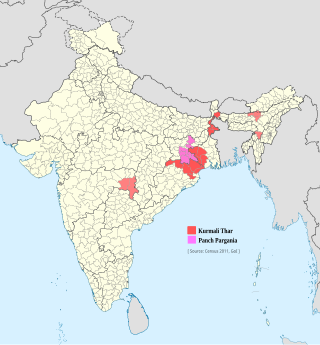
Jharkhand is a state in eastern India. The state shares its border with the states of West Bengal to the east, Chhattisgarh to the west, Uttar Pradesh to the northwest, Bihar to the north and Odisha to the south. It is the 15th largest state by area, and the 14th largest by population. Hindi is the official language of the state. The city of Ranchi is its capital and Dumka its sub-capital. The state is known for its waterfalls, hills and holy places; Baidyanath Dham, Parasnath, Dewri and Rajrappa are major religious sites. Jharkhand is primarily rural, with about 24% of its population living in cities.

Bhojpuri is an Indo-Aryan language native to the Bhojpur-Purvanchal region of India and the Terai region of Nepal. It is chiefly spoken in eastern Uttar Pradesh, western Bihar and western Jharkhand in India as well as western Madhesh and eastern Lumbini in Nepal. It is an eastern Indo Aryan language and as of 2000 it is spoken by about 5% of India's population. Bhojpuri is a descendant of Magadhi Prakrit and is related to Maithili, Magahi, Bangla, Odia, Assamese, and other eastern Indo-Aryan languages.

Magahi, also known as Magadhi, is a Indo-Aryan language spoken in Bihar, Jharkhand and West Bengal states of eastern India, and in the Terai of Nepal. Magadhi Prakrit was the ancestor of Magahi, from which the latter's name derives.
Nagpuri may refer to the following entities associated with India:
Chik Baraik or Baraik are a tribal community originally from the Chota Nagpur plateau and neighbouring states of Chhattisgarh, and Odisha.

Kurmali or Kudmali is an Indo-Aryan language classified as belonging to the Bihari group of languages spoken in eastern India. As a trade dialect, it is also known as Panchpargania, for the "five parganas" of the region it covers in Jharkhand. Kurmali language is spoken by around 550,000 people mainly in fringe regions of Jharkhand, Odisha and West Bengal, also a sizeable population speak Kurmali in Assam tea valleys. Kurmali is one of the demanded languages for enlisting in Eighth Schedule to the Constitution of India.
Most of the languages of Bihar, the third most populous state of India, belong to the Bihari subgroup of the Indo-Aryan family. Chief among them are Bhojpuri, spoken in the west of the state, Maithili in the north, Magahi in center around capital Patna and in the south of the state. Maithili has official recognition under the Eighth Schedule to the Constitution of India. The official language of Bihar is Modern Standard Hindi, with Standard Urdu serving as a second official language in 15 districts.

Khortha or alternatively classified as Eastern Magahi is a language variety spoken primarily in the Indian state of Jharkhand, mainly in 16 districts of three divisions: North Chotanagpur, Palamu division and Santhal Pargana. Khortha is spoken by the Sadaans as native language and used by the tribal as a link language. It is the most spoken language variety of Jharkhand.
The Nagvanshis of Chotanagpur, also known as the Khokhra chieftaincy, was an Indian dynasty which ruled the parts of Chota Nagpur plateau region during much of ancient, medieval and modern period. Phani Mukut Rai is considered the first king of dynasty claim to be son of Pundrika Naga, a mythical Naga. Lal Chintamani Sharan Nath Shahdeo (1931–2014) was last ruling king of the dynasty, until the estate was merged to the Republic of India.
The state of Jharkhand in India is located in the eastern part of the country and is known for its vivid culture, distinct paintings, traditions and festivals.
The Nagpuria people, also Nagpuri or Sadan, are an Indo-Aryan speaking ethnolinguistic group who are the native speakers of the Nagpuri language and natives of the western Chota Nagpur Plateau region of Indian states of Jharkhand, Bihar, Chhattisgarh and Odisha.
Sadan are the native Indo-Aryan-speaking ethnolinguistic groups of Chota Nagpur Plateau consist of Indian state of Jharkhand and neighbouring states who speak Nagpuri, Khortha and Kurmali language as their native language.
The Sadanic languages are Bihari languages in the Indo-Aryan languages. The languages are mostly spoken in the Jharkhand state of India.
Girdhari Ram Gonjhu was a prominent scholar of the Nagpuri language. He was former chairman of the Tribal-Regional Language Department at Ranchi University in state of Jharkhand. He was awarded Padma Shri for his contribution in the field of literature and education in the Jharkhand posthumously in 2022.
Nagpuri literature refers to literature in the Nagpuri language, the language of Jharkhand, Chhattisgarh and Odisha. The earliest literature started in the nagpuri language when the Nagvanshi king and king of Ramgarh Raj started writing poetry in the 17th century. Since then, various literature has been written. Although in the present century, Nagpuri was never considered worthy of literary development. But some dedicated writers have engaged in writing short stories, plays and poetry.
Nagpuri culture refers to the culture of the Nagpuria people, the native speakers of the Nagpuri language, which includes literature, festivals, folk song and dance. It is also referred to as the culture related to the Nagpuri language.
Bhuneshwar Anuj was an Indian journalist, writer and scholar. He is known for his journalism and scholarly works in the Nagpuri language. He also has a prominent role in the separate state movement of Jharkhand. He was central adviser of Lok Seva Samiti.
Lohra is a community found in Jharkhand. They are traditionally associated with works of iron smelting.







